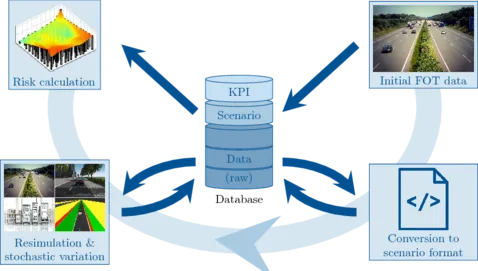Risk Assessment of Automated Vehicles
Motivation

Still about one million road users are killed worldwide. While the the overall number of casualties decreases, the share of vulnerable road users like pedestrians and cyclists increases. The is evidence that the decrease is caused by modern advanced driving assistance systems (ADAS) among others. Whereas these do not affect road users, automated driving offers the potential to decrease their statistics furthermore. Certainly this needs to be proven before the release of new automated driving functions.
The systems and algorithms used in automated driving are too complex to proof their reliability directly in general. That is why it is common to call a such systems corroborated through intensive testing instead of validated. How much testing is necessary for cars can derived from the ISO-norm 26262 and calculates to about 5 · 109 kilometers of faultless driving for automated vehicles. This ensures that the system is safer than a human driver by a given certainty. Of course this amount of real road driving is not feasible for testing every new automated driving function in every development stage. That is why assessment methods for complex driving functions have been developed to effectively and efficiently ensure safety.
This work focuses on scenario-based methods and the use of virtual test domains in the assessment of automated driving functions. The goal is to gain global and dense knowledge of the functions capabilities within the space of possible real world driving scenarios by verifying virtual domains against field operational tests (FOT) and using gathered information for illumination of the scenario space through resimulation.
Research Questions
- How is a meaningful measure of risk for automotive scenarios defined?
- How can the different test domains be cross-verified to enable their use in assessment?
- How can one asses the scenario space?